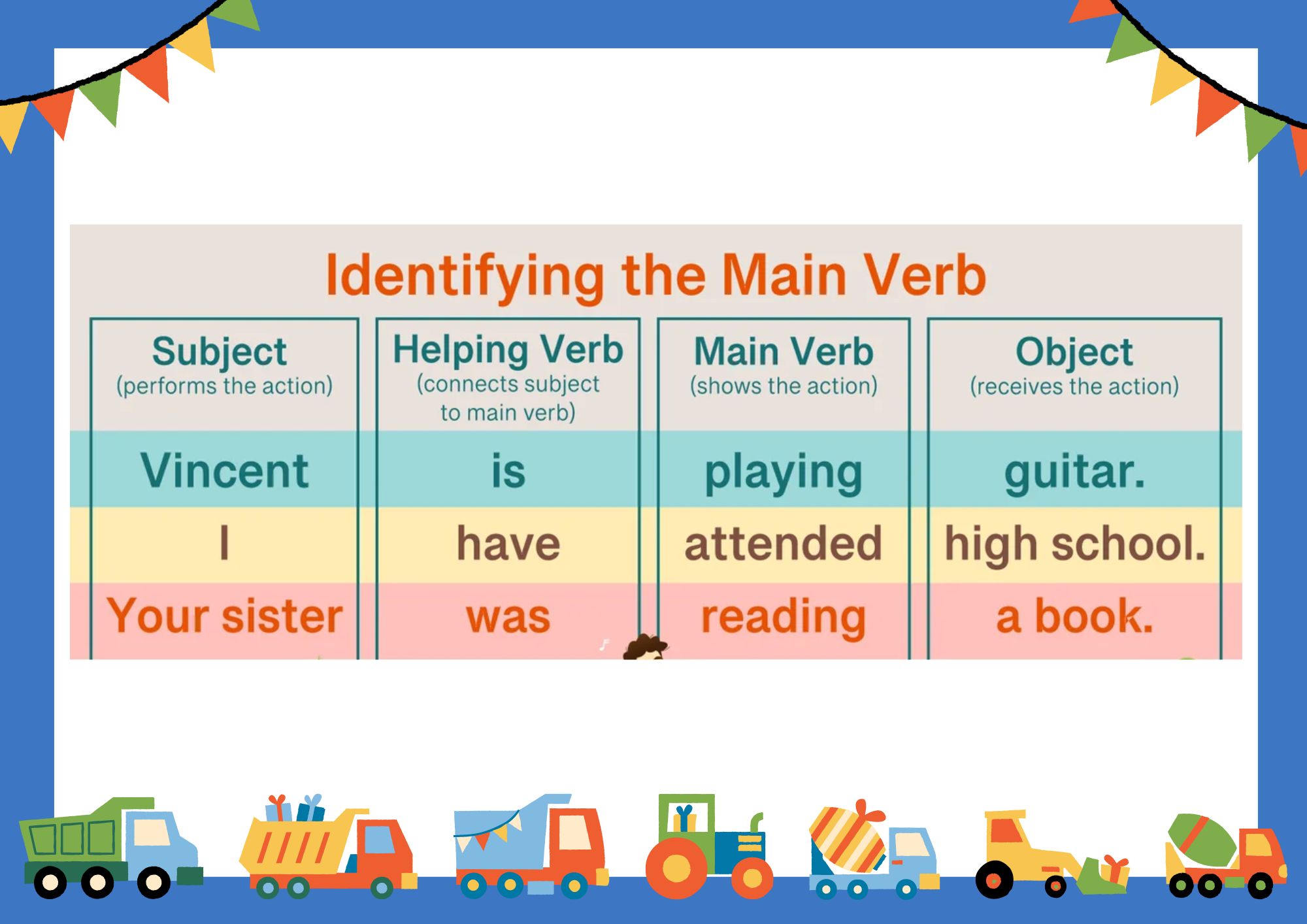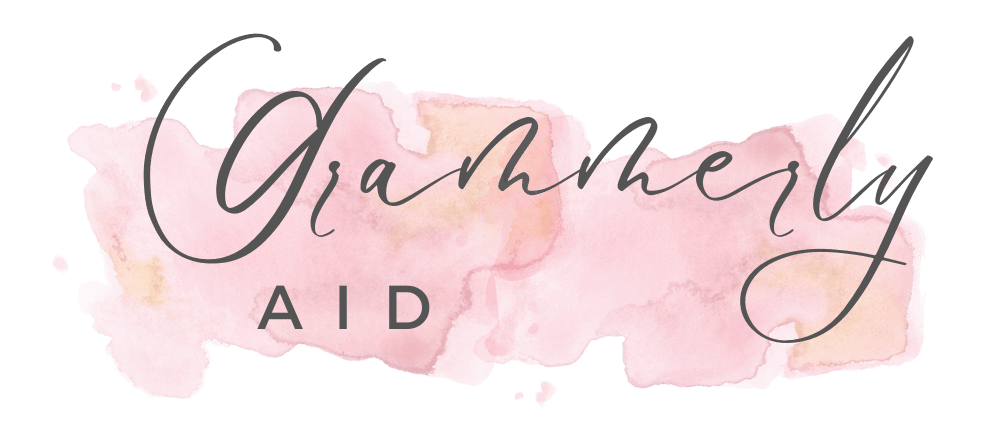Language is like a colorful tapestry, and verbs are the threads that weave the fabric of sentences together. Within the realm of verbs, we encounter two essential players – main verbs and auxiliary verbs. Let’s embark on a linguistic journey to understand the roles of these dynamic duo members.
Verb:
Every verb is a term which tells us that something is being performed, whatever condition anyone is in, or if an individual has something. Every phrase has a primary verb, an auxiliary verb, or both. The verb is the most essential element of the subject since it characterizes or signifies the behavior, condition, or incidence. A verb is a movement word that indicates us what the sentence’s subject seems to be doing.

What is a Main Verb?
The verbs which are used independently without help from other verbs are called main verbs or principal verb. The main verb, also known as the principal verb or lexical verb, is the primary verb in a sentence that expresses the main action or state of being. It carries the core meaning of the sentence.

Examples of main verbs :
- Run: The dog likes to run in the park.
- Jump: I can jump really high.
- Eat: She loves to eat pizza.
- Play: We always play together after school.
- Read: He enjoys to read books before bedtime.
- Am: I am a good friend.
- Is: The cat is fluffy.
- Are: We are in the same class.
- Look: The flowers look beautiful.
- Taste: The soup tastes delicious.
Types of Main Verbs:
The three types of main verbs are listed below:
- Transitive and Intransitive Verb
- Regular and Irregular Verb
- Finite and Infinite Verb
Transitive Verbs:
- A transitive verb is a verb that needs a direct object to complete its meaning.
- In simpler terms, it’s an action that someone or something does to something else.
Examples:
- I ate (transitive) the cake.
- Here, “ate” is the verb, and “the cake” is the direct object. The action of eating is done to the cake.
- She throws (transitive) the ball.
- “Throws” is the verb, and “the ball” is the direct object. The action of throwing is done to the ball.
Intransitive Verbs:
- An intransitive verb is a verb that doesn’t need a direct object to complete its meaning.
- It’s an action that doesn’t transfer to something or someone else.
Examples:
- I run (intransitive) every morning.
- In this sentence, “run” is the verb, but there’s no direct object. The action is not done to anything specific; it’s just the act of running.
- The cat sleeps (intransitive) peacefully.
- Here, “sleeps” is the verb, and there’s no direct object. The cat is simply sleeping without doing the action to anything else.
Regular Verbs:
- Regular verbs follow a consistent pattern when forming their past tense and past participle. Typically, the past tense is formed by adding “-ed” to the base form of the verb.
Examples of Regular Verbs:
- Walk: I walked to school yesterday.
- Talk: She talked to her friend on the phone.
- Play: We played games all evening.
In each of these examples, the regular verbs “walk,” “talk,” and “play” take on the “-ed” ending to indicate past tense.
Irregular Verbs:
Irregular verbs do not follow the standard pattern when forming their past tense and past participle. They have unique forms that need to be memorized.
Examples of Irregular Verbs:
- Go: I went to the store.
- Eat: She ate dinner an hour ago.
- Sing: We have sung that song before.
Finite verbs:
A finite verb is a verb that has a subject and shows tense, person, and number. It indicates when the action is happening and who is performing it.
- Finite verbs change their form according to the subject and the tense of the sentence.
Examples of Finite Verbs:
- She runs every morning. (Present tense)
- They were playing in the park. (Past tense)
- He will study for the test. (Future tense)
In each of these examples, the finite verbs (“runs,” “were,” “will study”) carry information about the subject and the time of the action.
Non-finite Verbs:
- Non-finite verbs, on the other hand, do not have a subject and do not show tense, person, or number. They are not bound by the subject of the sentence, and they are often used in a more general or abstract sense.
There are three types of non-finite verbs: infinitives, gerunds, and participles.
Examples of Non-finite Verbs:
- Infinitive: To run is good exercise.
- In this example, “to run” is an infinitive. It does not have a specific subject or tense.
- Gerund: Swimming is her favorite activity.
- “Swimming” is a gerund. It functions as a noun in the sentence, and it doesn’t indicate when the action is happening.
- Participle: The broken vase needs to be replaced.
- “Broken” is a participle. It modifies the noun “vase” and doesn’t have a subject or tense.
In summary, finite verbs convey specific information about the subject and tense, while non-finite verbs are more general and lack subject-specific and tense-specific information.
some commonly used verbs:



Function of Main Verbs:
The main verb, also known as the lexical verb or principal verb, is a crucial element in a sentence. It expresses the main action or state of being in a sentence and provides the primary information about what is happening. The main verb is typically supported by other elements such as auxiliary verbs, objects, and adverbs.
Here are some examples to illustrate the function of main verbs:
- Action Verbs:
- She runs every morning.
- They built a new house.
- He writes interesting articles.
- Linking Verbs:
- She is a doctor.
- The cake smells delicious.
- The movie seems interesting.
- Helping (Auxiliary) Verbs with Main Verbs:
- They are studying for exams.
- He has finished his work.
- She will visit her grandparents.
- Modal Verbs:
- She can swim.
- He must finish the project.
- They should attend the meeting.
In each of these examples, the main verb is the core element conveying the primary meaning or action in the sentence. Understanding the function of the main verb is crucial for comprehending the overall meaning of a sentence.
Common Mistakes while using Main Verbs:
If there are inconsistencies inside the usage of in main verb tenses, it affects context and understanding. The mistake might be a tense misrepresentation, an improper adjustment of future tense forms, or perhaps an inappropriate tense transfer in a group of words. Main Verb tenses could also be uneven across a paragraph. A typical language error occurs when a text begins in the present tense then eventually transitions to the past tense for no obvious cause.
Examples:
INCORRECT- That book is belonging to me.
CORRECT- That book belongs to me.
INCORRECT- Everyone are hardworking.
CORRECT- Everyone is hardworking.
INCORRECT- Rohan looks sadly.
CORRECT- Rohan looks sad.
INCORRECT– They have built the house since April last.
CORRECT– They have been building the house since April last.
INCORRECT– The lemon are tasted sour.
CORRECT– The lemon taste sour.
How to Differentiate between Main Verbs and Helping Verbs?
The basic distinction among main verbs as well as helping verbs the fact that the main verb would be the major verb in a phrase and symbolizes the major action performed either by topic within statement, meanwhile the helping verb is employed in conjunction with both the main verb to convey the verb’s tense.
Identifying Main Verbs:
Identifying the main verb in a sentence is an important skill. Here’s a simple guide with examples for kids:
1. Find the Action:
- Look for words that show an action or describe what someone or something is doing.
Example:
- The cat jumped over the fence.
In this sentence, “jumped” is the main verb because it tells us what the cat is doing (the action).
2. Ask “What is Happening?”:
- Ask yourself, “What is happening in this sentence?” The answer will often be the main verb.
Example:
- The kids laughed at the funny joke.
Here, “laughed” is the main verb because it tells us what the kids are doing (the action).
3. Look for Key Words:
- Words like run, play, eat, read, write, and others often indicate the main action.
Example:
- She reads a book every night.
In this sentence, “reads” is the main verb because it describes the action of what she does every night.
4. Identify the Doing Word:
- The main verb is often a “doing word” that shows an action.
Example:
- The bird sings in the morning.
Here, “sings” is the main verb because it shows what the bird does (the action).
5. Ignore Helping Words:
- Ignore words like is, am, are, was, were, has, have, had. These are helping verbs and not the main action.
Example:
- They are playing outside.
In this sentence, “playing” is the main verb. Ignore “are” as it is a helping verb.
Remember, the main verb is the word that tells us the main action or what is happening in the sentence. With practice, it becomes easier to spot the main verb in different sentences!
Examples of Main Verbs in Sentence:
- She plays hockey in school.
- We are going to Agra.
- He could eat all day.
- The kite was flying high.
- I am writing a story on animals.
- It rains a lot in Meghalaya.
- They sang beautifully in the party.
- I lived here since my childhood.
- He is begging for food and water.
- India is developing rapidly.
Practice worksheets on Main Verbs:
Identify the main verbs in the following sentences.
- He has been working all day.
- I play cricket.
- I am watching movie.
- My mother is cooking.
- Reshma played guitar.
- You really deserve this.
- He finished all his works.
- Would you prefer iced tea.
- I missed the comfort of my home.
- They stopped us to move ahead.
Answers:
- He has been working all day.
- I play cricket.
- I am watching movie.
- My mother is cooking.
- Reshma played guitar.
- You really deserve this.
- He finished all his works.
- Would you prefer iced tea.
- I missed the comfort of my home.
- They stopped us to move ahead.
Worksheet : Identify the Main Verb
Instructions: Read each sentence and underline the main verb.
- The cat sleeps on the windowsill.
- Jake and Lily play in the park every evening.
- My sister loves to sing.
- The sun sets in the west.
- We will bake cookies for the school party.
Answers:
- The cat sleeps on the windowsill.
- Main Verb: sleeps
- Jake and Lily play in the park every evening.
- Main Verb: play
- My sister loves to sing.
- Main Verb: loves, sing
- The sun sets in the west.
- Main Verb: sets
- We will bake cookies for the school party.
- Main Verb: will bake
Worksheet : Complete the Sentences with the Correct Main Verb
Instructions: Fill in the blanks with the appropriate main verb from the word bank.
Word Bank: read, jump, swim, dance, eat
- The children __________ in the pool.
- Sarah and Tom __________ a story together.
- The cat __________ on the roof.
- I __________ my breakfast every morning.
- The students __________ happily at the school assembly.
Answers:
- The children swim in the pool.
- Sarah and Tom read a story together.
- The cat jumps on the roof.
- I eat my breakfast every morning.
- The students dance happily at the school assembly.

